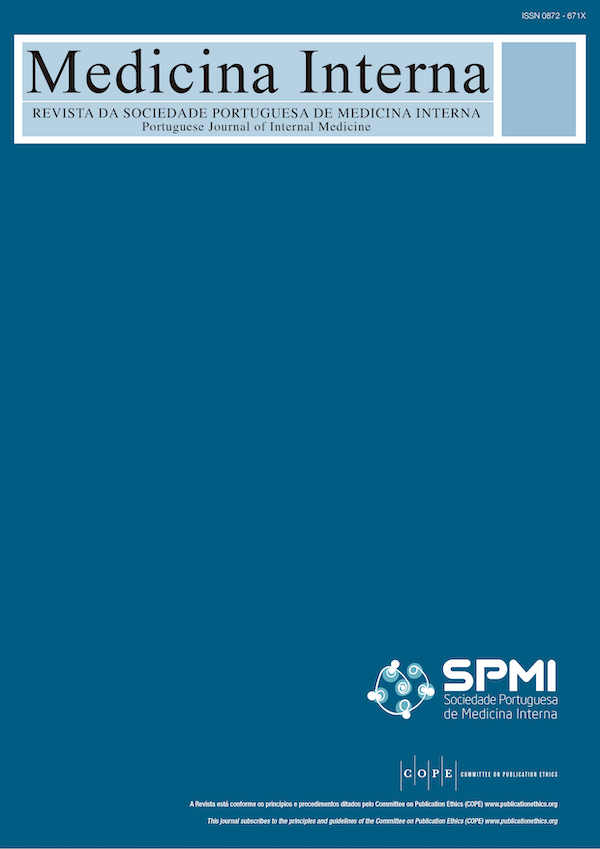An Audit of Oxygen Therapy Practices in an Internal Medicine Ward
DOI:
https://doi.org/10.24950/rspmi/O/128/19/4/2019Keywords:
Clinical Audit, Hospital Departments, Internal Medicine, Oxygen Inhalation TherapyAbstract
Introduction: Oxygen (O2
) prescription is frequent in an Internal Medicine ward. Recommendations such as the British Thoracic Society establish the appropriate use of O2
in health care.
Our objective was to evaluate O2
therapy procedures in an
Internal Medicine ward, in light of 2017 British Thoracic Society
recommendations.
Methods: We conducted an observational study, during a
period of 48 hours, which included patients admitted to the Internal Medicine ward of Hospital Central do Funchal, under oxygen
therapy, with or without prescription. We analysed:
1) the reason for the prescription,
2) the type of prescription (fixed dose versus peripheral O2
interval saturation oriented dose),
3) accordance between prescription and administration, and
4) monitoring (prescription and registration).
Results: From a total of 116 hospitalized patients, 114 (98%)
had O2
prescription. Six patients (5.3%) had no hypoxemia, and
57 (50%) had no hypoxemia assessment registration. From the
114 patients with a prescription, only 38 (33%) had targeted saturation range objectives. Of these, 61% did not have prescribed
the maximum saturation target and only 8% had the two interval
limits defined. From 76 patients (67%) with fixed dose prescription, none had the registrations of the four recommended parameters. Eight (11%) did not receive O2 therapy and 39 (51%) were
receiving an O2
dose different from the one prescribed. Monitoring was performed, on average, 2.16 times in a 24 hours period.
Five patients (4%) had no monitoring record.
Conclusion: The majority of O2
therapy prescriptions did not
meet the current recommendations. Therefore, practice optimization is needed in the prescription, administration and monitoring of O2
therapy steps. It is necessary to raise awareness among
health professionals and reprise outcome audition.
Downloads
References
O’Driscoll BR, Howard LS, Earis J, Mak V; British Thoracic Society Emergency Oxygen Guideline Group; BTS. BTS guideline for oxygen use in adults in healthcare and emergency settings. Thorax. 2017; 72: i1–i90. doi: 10.1136/thoraxjnl-2016-209729.
Neves J, Sousa C, Marques T, Barbosa M, Pereira P, Ramos S, et al. Auditoria de oxigenoterapia em duas enfermarias de medicina. Rev Med Interna. 2011; 18: 129-36.
Neves JT, Lobão MJ, Grupo de trabalho EMO. Estudo multicêntrico de oxigenoterapia - uma auditoria nacional aos procedimentos de oxigenoterapia em enfermarias de medicina interna. Rev Port Pneumol. 2012; 18: 80-5.
Guedes LP, Delfino FC, Faria FP, Melo GF, Carvalho GA. Adequacy of oxygenation parameters in elderly patients undergoing mechanical ventilation. Einstein. 2013; 11: 467-71.
Wijesinghe M, Shirtcliffe P, Perrin K, Healy B, James K, Weatherall M, et al. An audit of the effect of oxygen prescription charts on clinical practice. Postgrad Med J. 2010; 86: 89-93. doi: 10.1136/pgmj.2009.087528.
Dodd ME Kellet F, Davis A, Simpson JC, Webb AK, Haworth CS. Audit of oxygen prescribing before and after the introduction of a prescribing chart. BMJ. 2000; 321: 864-5.
Boyle M, Wong J. Prescribing oxygen therapy. An audit of oxygen prescribing practices on medical wards at North Shore Hospital, Auckland, New Zealand. N Z Med J. 2006 21;119:U2080.
Wong C, Visram F, Cook D, Griffith L, Randall J, O’Brien B. Development, dissemination, implementation and evaluation of a clinical pathway for oxygen therapy. CMAJ. 2000;162:29-33.
Albin RJ, Criner GJ, Thomas S, Abou-Jaoude S. Pattern of non-ICU inpatient supplemental oxygen utilization in a university hospital. Chest. 1992;102:1672-5.
Downloads
Published
How to Cite
Issue
Section
License
Copyright (c) 2019 Medicina Interna

This work is licensed under a Creative Commons Attribution 4.0 International License.
Copyright (c) 2023 Medicina Interna






